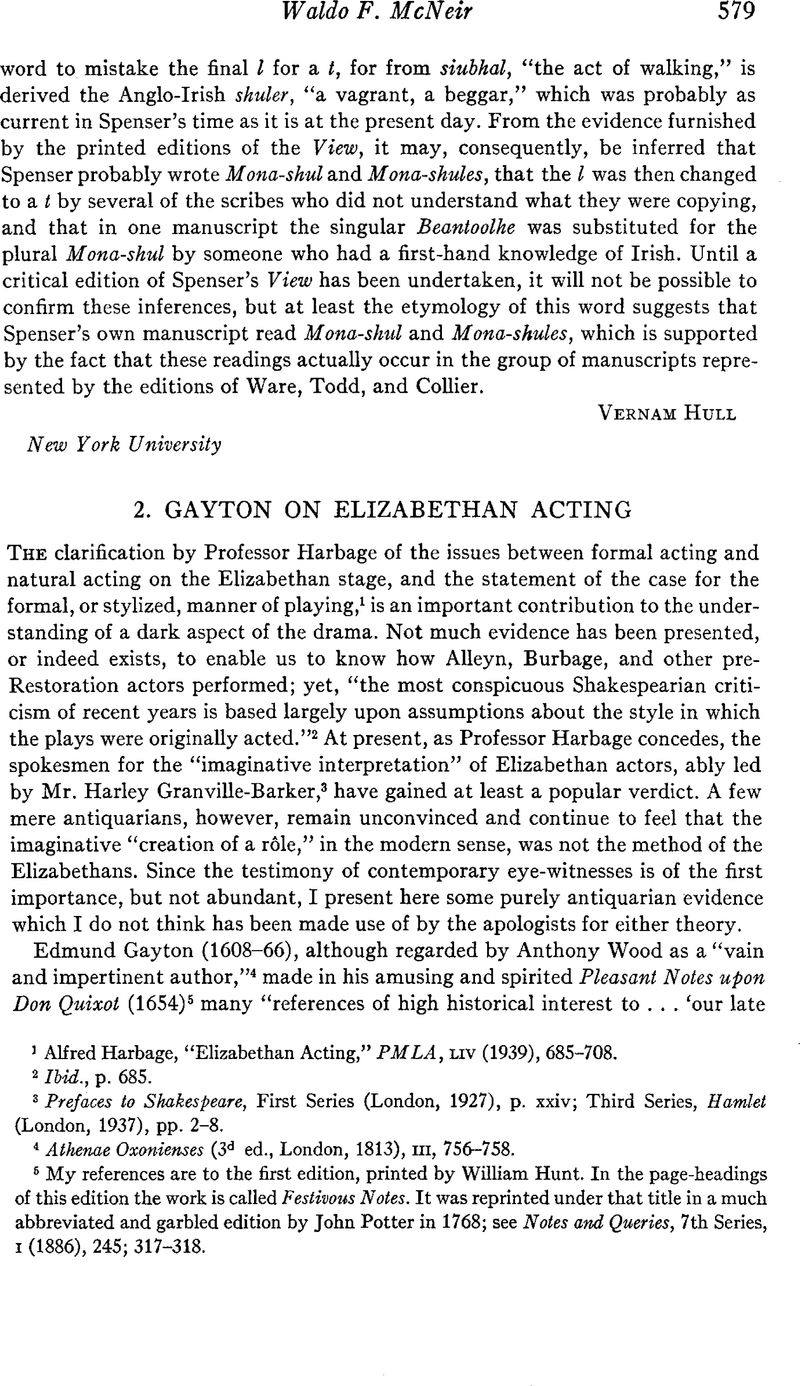Article contents
Gayton on Elizabethan Acting
Published online by Cambridge University Press: 02 December 2020
Abstract

- Type
- Comment and Criticism
- Information
- Copyright
- Copyright © Modern Language Association of America, 1941
References
Note 1 in page 579 Alfred Harbage, “Elizabethan Acting,” PMLA, liv (1939), 685–708.
Note 2 in page 579 Ibid., p. 685.
Note 3 in page 579 Prefaces to Shakespeare, First Series (London, 1927), p. xxiv; Third Series, Hamlet (London, 1937), pp. 2–8.
Note 4 in page 579 Atkenae Oxonienses (3d ed., London, 1813), iii, 756–758.
Note 5 in page 579 My references are to the first edition, printed by William Hunt. In the page-headings of this edition the work is called Festivous Notes. It was reprinted under that title in a much abbreviated and garbled edition by John Potter in 1768; see Notes and Queries, 7th Series, i (1886), 245; 317–318.
Note 6 in page 580 Sidney Lee in DNB, vii, 974. See also, C. Elliot Browne, “Gayton's Allusions to Shakespeare and the Early Stage,” Notes and Queries, 5th Series, iii (1875), 161–162; and “S.,” “Edmund Gayton,” Ibid., x (1878), 301–303.
Note 7 in page 580 Pleasant Notes upon Don Quixot, p. 268.
Note 8 in page 580 Ibid., pp. 272–273.
Note 9 in page 580 According to Wood, op. cit., iv, 275, Gay ton acted a part in Love's Hospital, by George Wilde, a play presented before the King and Queen at St. John's in 1636.
Note 10 in page 580 Op. cit., pp. 694–695.
Note 11 in page 580 Betterton was engaged by Rhodes to play in the Cockpit company of actors about 1659, and at once became pre-eminent; see Allardyce Nicoll, History of Restoration Drama (Cambridge, 1928), pp. 65–66. The best description of his style of acting is Antony Aston's in his Supplement to Theophilus Cibber's Lives of the Actors, pp. 120–122. After Betterton had won acclaim in England, Michel Baron (1653–1729) emerged as the great exponent of the natural style in France; see Arthur Tilley, “Tragedy at the Comédie Française, 1680–1778,” MLR, xvii (1922), 364. Professor Harbage calls Betterton “the Michel Baron of the English stage,” op. cit., p. 693. Perhaps the point is trifling, but it would be truer to chronology to call Baron the Betterton of the French stage.
Note 12 in page 581 DNB, vii, 973.
Note 13 in page 581 J. P. Collier, History of English Dramatic Poetry (London, 1831), i, 393, 430–431; T. W. Baldwin, Organisation and Personnel of the Shakespearean Company (Princeton, 1927), pp. 177–178, 198–200, 384–385.
Note 14 in page 581 Baldwin, op. cit., pp. 181–184.
Note 15 in page 581 Pleasant Notes upon Don Quixot, p. 25.
Note 16 in page 581 Ibid., p. 24.
Note 17 in page 581 Poetaster, iii, iv, 126.
Note 18 in page 581 See Thornton S. Graves, “Some References to Elizabethan Theaters,” SP, xix (1922), 323, note 5.
Note 19 in page 581 E. K. Chambers, Elizabethan Stage (Oxford, 1923), ii, 447.
Note 20 in page 582 Pleasant Notes upon Don Quixot, pp. 140–141.
Note 21 in page 582 Ibid., p. 144.
Note 22 in page 582 Muriel C. Bradbrook, Elizabethan Stage Conditions (Cambridge, 1932), pp. 105 ff. See also, Georg Hartmann, “Die Bühnengesten in Shakespeare's Dramen als Ausdruck von Gemütsbewegungen,” Shakespeare Jahrbuch, N. F., i (1924) 41–61.
Note 23 in page 582 Frances A. Foster, “Dumb show in Elizabethan Drama before 1620,” Englische Studien, xliv (1912), 8–17; B. R. Pearn, “Dumb-Show in Elizabethan Drama,” RES, xi (1935), 395–402.
Note 24 in page 582 Harbage, op. cit., p. 703.
Note 25 in page 582 Pleasant Notes upon Don Quixot, pp. 258–259.
- 1
- Cited by


